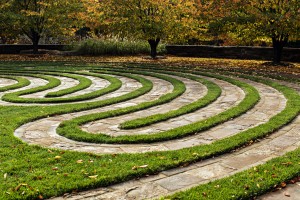
Labyrinths-circular paths for walking meditation that have been widely adapted by churches, hospitals and retreat centers-are now popping up in upscale American backyards. “There are 3,740 labyrinths in the U.S.-it’s really blossoming,” said Lauren Artress, author of “Walking a Sacred Path: Rediscovering the Labyrinth as a Spiritual Practice.” Some are simple, such as the 30-foot spiral of desert stones that Andrew Weil, the physician, author and founder of the University of Arizona Center for Integrative Medicine, built at his home in Tucson. Other, more lavish walkways evoke the 13th-century labyrinth of Chartres Cathedral in France.
Unlike a maze, which is designed to confuse with multiple paths and dead ends, a classical labyrinth has just one winding path to the center and one path out. “As a relaxation technique, a technique for promoting mindfulness, it’s very useful,” Dr. Weil said. “You go around and around and back and forth, but eventually you reach a central point…Seeing the goal there, but not getting to it directly-there’s something metaphoric about that.”
Getting that Zen-like peace can require commitment. Elaborate labyrinths, with lush landscaping, intricate stonework and irrigation, can easily start at around $40,000.
“It’s very much a part of my life now. If the mood strikes, or I’m having a rough day, it’s the best place to go-with grief you never know,” said Ms. Corckran.
Everyone is different and looks for peace where ever they can find it. The gospel of Jesus Christ offers the most rewarding peace and it is free. Prayer can be enjoyed anywhere and at any time.
If you like the idea of experiencing the Labyrinth effect but don’t have the space or money, you could always go to Ikea!
